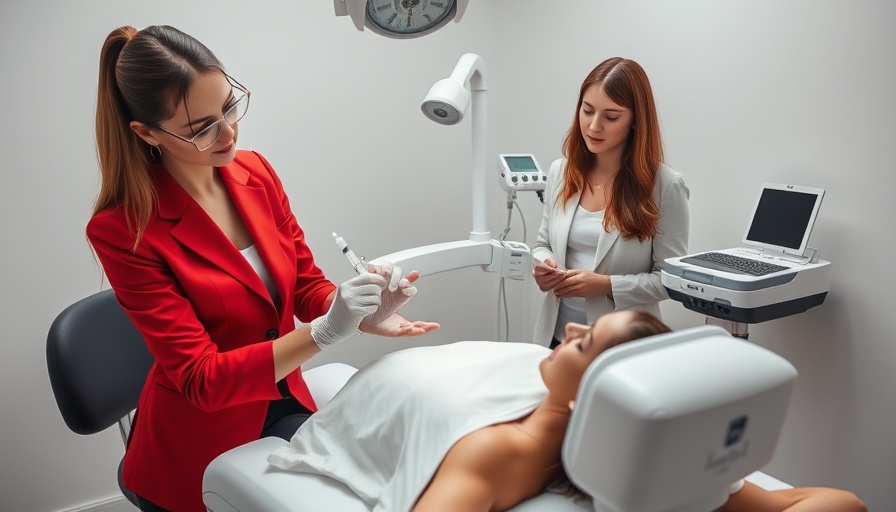
Understanding the Global Landscape of Aesthetic Regulations
The aesthetic industry is not only experiencing a meteoric rise in popularity but also a profound divergence in the regulatory practices across the globe. As more individuals seek cosmetic procedures to enhance their appearance, it becomes crucial to understand the varying levels of safety, ethical standards, and patient protections in different countries. With some regions imposing stringent laws on practitioners and procedures, while others remain notoriously unregulated, the disparity can have serious implications for both practitioners and patients.
Australia's Stringent Framework: A Model for Safety
Australia stands as a beacon of regulation within the aesthetic market. The strict guidelines enforced by the Medical Board of Australia and the Australian Health Practitioner Regulation Agency indicate a clear commitment to patient safety. Recent changes, such as mandatory in-person consultations before prescribing controlled substances like botulinum toxin and dermal fillers, underscore an effort to ensure that patients do not rush into procedures without fully understanding the risks involved.
Moreover, the prohibition on asynchronous prescribing marks a significant step towards preventing misuse within the industry. These regulations not only protect patients but also define ethical standards that should be followed globally.
A Closer Look at Germany's Regulatory Strengths
Germany's stringent legal framework also exemplifies a market focused on patient protection. Here, only licensed medical doctors can perform cosmetic procedures, which helps in maintaining a high standard of care. The country’s Heilmittelwerbegesetz restricts misleading advertisements, ensuring that companies cannot exploit vulnerable individuals seeking enhancements. This level of care serves as an essential benchmark for the global aesthetic industry.
Nevertheless, while Germany's model is commendable, there can be concerns about accessibility, as the narrow focus on medical professionals may limit options for patients seeking less invasive treatments, provided by trained professionals without medical licenses.
South Korea: A High-Demand Market with Robust Regulations
South Korea, globally recognized for its advanced beauty standards and cosmetic innovations, pairs its high demand for aesthetic procedures with a strong regulatory framework. The combination of skilled practitioners and a strict legal environment helps ensure that patients are well cared for. Nevertheless, the relentless societal pressure for perfection in South Korea often leads to an increase in procedural demand, creating a balancing act between patient choice and ethical practice. The state’s commitment to rigorous licensing practices helps maintain safety amid this cultural phenomenon.
Contrasts in Regulation: Countries with Minimal Oversight
In stark contrast, several countries around the world lack adequate regulatory frameworks for aesthetic procedures, leading to significant concerns about patient safety. The proliferation of unlicensed practitioners represents a critical challenge, with vulnerable individuals at risk of receiving subpar treatments that could lead to severe complications. Without cohesive regulatory standards, the international aesthetic market faces the threat of inconsistency in service quality, potentially undermining patient trust and safety.
The Ethical Implications of Cosmetic Procedures
As the aesthetic industry continues to flourish, ethical considerations must guide its evolution. Questions regarding who should be allowed to perform procedures and how the industry communicates risks are paramount. The rapid rise of social media and influencer marketing significantly influences public perception, making it vital for practitioners to adhere to ethical advertising practices that do not misrepresent the outcomes of aesthetic procedures.
Future Trends in Aesthetic Regulations
Looking ahead, as consumer demand for aesthetic procedures increases, there will likely be a push for establishing international regulatory standards. Countries may adopt more comprehensive guidelines influenced by successful frameworks in places like Australia and Germany. This harmonization could foster a safer environment for patients and practitioners alike while enhancing the industry’s reputation.
What Can Patients Do? An Informed Approach
For consumers, staying informed is key in navigating the complex landscape of aesthetic procedures. Patients are encouraged to thoroughly research practitioners, understand the regulatory environment in their respective countries, and remain aware of their rights. By holding practitioners accountable and demanding adherence to ethical and safety standards, patients can contribute to a more robust aesthetic market.
In a world where aesthetic enhancements are increasingly normalized, understanding regulations, safety standards, and ethical practices is paramount for making informed choices. Advocating for regulatory improvements is a collective responsibility that will ultimately benefit everyone involved.
Call to Action: To ensure you are well-informed and protected in your aesthetic journey, take the time to understand the regulations in your area and advocate for more stringent practices if necessary. Your safety and rights as a patient matter!
 Add Row
Add Row  Add
Add 




Write A Comment